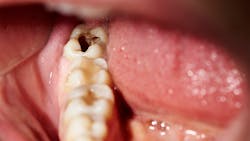Dear Patient: You can die from cavities
News stations recently reported that former NFL player Mike Williams’ autopsy revealed he died from bacterial sepsis due to “multiple dental caries and retained dental roots,” according to the Hillsborough County Medical Examiner’s Office in Florida. This means Mike Williams died because the bacteria from the infection in his mouth traveled to his brain and lungs. Back in September 2022, I wrote about why a little cavity is a big deal. And this case goes to show the dire consequences of untreated decay.
I have yet to learn how long it had been since Williams had seen a dentist, if he had insurance, or even the state of his mouth, but what I do know is that cavities get bigger over time—no matter what quick fix you see on the internet. Likely that decay had been left untreated for years. The retained dental roots could have happened because the entire crown of the tooth broke away, and all that was left was the roots to harbor the infection. There were probably times when Williams experienced tooth pain, but it could have subsided as the infection found places to go in his body.
The World Health Organization estimates that nearly two billion people suffer from untreated cavities in their permanent teeth and 514 million children in their baby teeth. This decay can affect their overall health if left untreated and, in extreme cases like Mike Williams', death.
Unfortunately, dental care is often an afterthought or even a luxury in our current system. Even if people have dental coverage or the financial means, they don’t seek treatment. Whether it’s due to fear, finances, or simply not understanding the importance of dental care, the CDC estimates that only 63% of Americans had a dental exam in 2022. At the same time, the American Dental Association says there are over two million visits to hospital emergency rooms for dental pain, costing the US health-care system $1.7 billion annually.
Prevention is the key
The frustrating thing here is that most oral diseases are preventable. As a dental hygienist, I am a prevention specialist. When patients come in for their “cleaning,” my goal is to keep them from needing to ever sit in the dentist’s chair. We can prevent oral disease together through proper homecare instruction, nutritional counseling, airway evaluation, and other assessments.
Act early
If you already have a cavity, get to it early before it becomes more extensive, painful, or life-threatening. Recently, I had a new college grad who had multiple cavities (and no money) reach out to me. Since it wasn’t hurting, she asked me if she could wait to treat them. I encouraged her to find a dental home that practices minimally invasive dentistry, using treatments such as silver diamine fluoride (SDF). SDF is a liquid that combines the remineralizing effects of fluoride and the antibacterial properties of silver to arrest decay and prevent it from spreading to other teeth. The only downside is it turns decayed areas black. But once the decay is stopped, she can save up to have the areas restored without worrying about the cavity growing.
Pay now—or pay later
Starting a mindset of prevention and early treatment will not only save you money at the dental office; it will also save your tooth structure. There’s nothing stronger or more functional than your natural teeth. No dental restoration will last forever. Once a tooth is drilled, it is compromised. Avoiding any fillings should be the goal. But if that’s not possible, let’s keep them as small as possible.
Ignoring dental issues or toughing them out is not the way to go. Go see a dentist! It could save your life.
Amanda Hill, BSDH, RDH, CDIPC, is an enthusiastic speaker, innovative consultant, and award-winning author who brings over 25 years of clinical dental hygiene and education to dentistry. Recipient of OSAP’s Emerging Infection Control Leader award and an active participant with the advisory board for RDH magazine, DentistryIQ, and OSAP’s Infection Control in Practice Editorial Review Board and membership committee, Amanda (also known as the Waterline Warrior) strives to make topics in dentistry accurate, accessible, and fun. She can be reached at [email protected].
About the Author

Amanda Hill, BSDH, RDH, CDIPC
Amanda Hill, BSDH, RDH, CDIPC, is an enthusiastic speaker, innovative consultant, and award-winning author who brings over 25 years of clinical dental hygiene and education to dentistry. Recipient of OSAP’s Emerging Infection Control Leader award and an active participant with the advisory board for RDH magazine, DentistryIQ, and OSAP’s Infection Control in Practice Editorial Review Board and membership committee, Amanda (also known as the Waterline Warrior) strives to make topics in dentistry accurate, accessible, and fun. She can be reached at [email protected].
